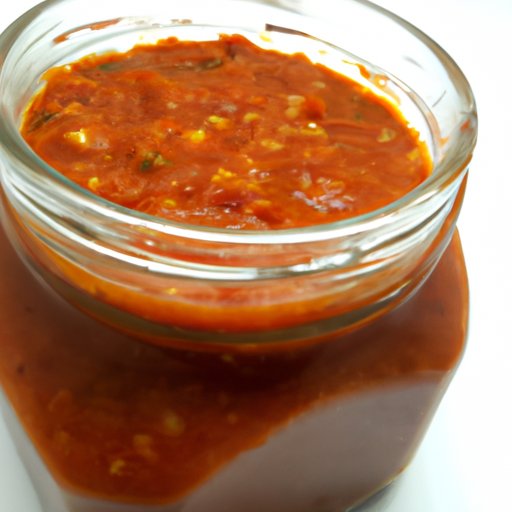
Introduction
There’s no doubt that spaghetti and meatballs is a classic dinner dish that everyone loves. And even if you’re not a pasta lover, you can’t deny that a good homemade sauce takes the dish to the next level. Making your own spaghetti sauce may seem daunting, but trust us, it’s actually quite easy and well worth the effort.
Not only is homemade spaghetti sauce healthier than store-bought alternatives, but it’s also much more flavorful. You have control over the quality of the ingredients and can adjust the recipe to suit your preferences. Additionally, making your own sauce allows you to customize it to complement any proteins or vegetables you choose to pair it with.
Step-by-Step Guide
Before diving into the recipe, let’s first gather all the necessary ingredients. You will need:
- 1 can of crushed tomatoes (28 oz.)
- 1 can of tomato paste (6 oz.)
- 1 small onion, finely chopped
- 4 cloves of garlic, minced
- 1 tablespoon of olive oil
- 2 teaspoons of sugar
- 1/2 teaspoon of dried basil
- 1/2 teaspoon of dried oregano
- 1/4 teaspoon of salt
- 1/4 teaspoon of black pepper
In terms of cooking methods and utensils, you will need a large pot, a wooden spoon, and a food processor or blender (optional).
To start, heat the olive oil in the pot over medium heat and add the chopped onion. Cook for 5-6 minutes until the onion is translucent. Then, add the minced garlic and cook for an additional 30 seconds until fragrant.
Next, add the can of crushed tomatoes, tomato paste, sugar, dried basil, and dried oregano. Stir to combine all the ingredients and bring the sauce to a simmer. Leave the sauce to cook for around 20-25 minutes, stirring occasionally to prevent it from burning or sticking to the bottom of the pot.
Once the sauce has thickened to your desired consistency, remove it from the heat to cool. Some people prefer to keep it as is, while others like to use a food processor or blender to get a smoother texture.
Ingredient Upgrades
While the base recipe is simple and delicious on its own, it’s always fun to play around with different flavor profiles and ingredients. Here are some suggestions to enhance the flavor of your sauce:
– Fresh herbs and spices: You can substitute the dried herbs for fresh ones, such as basil, oregano, parsley, or thyme. These will add brightness and depth to your sauce.
– Seasonal vegetables: Feel free to add a variety of vegetables to your sauce to amplify its flavor. Some ideas include carrots, zucchini, bell peppers, mushrooms, or spinach. Not only do they add flavor, but they also boost the nutritional value of your dish.
– Cheeses: Cheese is a fantastic ingredient to add richness to your spaghetti sauce. Parmesan, ricotta, or mozzarella are popular choices. Consider using different cheeses depending on the type of pasta you choose or the protein you’re pairing the sauce with.
Seasonal Twist
Another way to spice up your homemade spaghetti sauce is to experiment with seasonal fruits and vegetables. Here are some ideas to try:
– Summer peaches: Sliced or diced peaches can add a tangy-sweet flavor to your pasta sauce. They work particularly well with pork or chicken.
– Butternut squash: Adding roasted butternut squash to your sauce gives it a festive, autumnal spin. This pairs well with beef or lamb.
– Canned pumpkin puree: Like butternut squash, pumpkin puree is a seasonal twist that lends itself to a delicious sauce when mixed with savory flavors like garlic and thyme. Serve with a protein like shrimp or salmon.
Food Pairing Suggestions
Homemade spaghetti sauce is so versatile that it can be paired with a variety of proteins and pasta shapes. Here are some suggestions to get you started:
– Protein: Ground beef, turkey, chicken, or even veggie crumbles are great protein options. You can also try pairing the sauce with seafood like shrimp or clams.
– Pasta: Spaghetti is the classic choice, but you can mix it up with penne, fettuccine, or farfalle. Choosing a whole-grain pasta will add more fiber and nutrients to your meal.
– Veggies: As mentioned before, adding vegetables to your sauce can increase its flavor profile. Serve the sauce over grilled or roasted vegetables like eggplant, zucchini, or portobello mushrooms for a hearty and healthy meal.
Health Benefits
Homemade spaghetti sauce is much healthier for you than a store-bought alternative. While store-bought sauces often contain preservatives and added sugars, homemade sauces allow you to control exactly what goes into your food. Additionally, cooking with fresh vegetables, herbs, and spices provides ample vitamins, minerals, and antioxidants that store-bought sauces might lack.
Conclusion
Not only is making homemade spaghetti sauce easy, but it’s also rewarding and delicious. The best part is that there’s no need to follow the recipe to the letter – feel free to experiment and adjust the ingredients to your liking. So next time you’re craving spaghetti and meatballs, skip the jar and make your own sauce from scratch.




